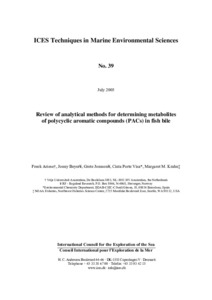Review of analytical methods for determining metabolites of polycyclic aromatic compounds (PACs) in fish bile.

View/
Average rating
votes
Date
2005Author
Ariese, F.
Beyer, J.
Jonsson, G.
Porte, C.
Krahn, M.M.
Status
PublishedPages
41pp.
Metadata
Show full item recordAbstract
In fish, metabolites of polycyclic aromatic compounds (PACs) in gall bladder bile can be used as biomarkers for recent environmental exposure to PACs. These metabolites in the bile result from hepatic biotransformation processes whereby the lipophilic parent PACs are transformed in two steps (hydroxylation and subsequent conjugation) to more soluble forms and then passed to the gall bladder for elimination from the organism. As a biomarker of exposure, the determination of PAC metabolites in bile has several advantages over other assessment techniques. Several bile PACs are strong fluorophores and can thus be measured semi-quantitatively and very easily by means of straightforward fluorescence detection techniques. For example, fixed fluorescence detection and synchronous fluorescence scanning can be used for this purpose. These techniques are excellent for rapid screening of overall PAC exposure levels, but less suitable for the determination of individual compounds. The next level of.....
Resource URL
http://ices.dk/publications/library/Publisher
International Council for the Exploration of the Sea (ICES)Copenhagen, Denmark
Series;Nr
ICES Techniques in Marine Environmental Sciences;39Document Language
enSustainable Development Goals (SDG)
14.A14.1
Best Practice Type
Standard Operating ProcedureGuide
ISSN
0903–2606Citation
Ariese, F.; Beyer, J.; Jonsson, G.; Porte, C. and Krahn, M.M. (2005) Review of analytical methods for determining metabolites of polycyclic aromatic compounds (PACs) in fish bile. ICES Techniques in Marine Environmental Sciences, No. 39, 41pp. DOI: http://dx.doi.org/10.25607/OBP-225Collections
 Repository of community practices in Ocean Research, Applications and Data/Information Management
Repository of community practices in Ocean Research, Applications and Data/Information Management